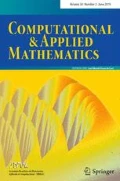Abstract
In this paper, we establish multiple closed-form solutions for all the variables in the Lucas–Uzawa model with externalities for the case with no parameter restrictions as well as for cases with specific parameter restrictions. These multiple solutions are derived with the help of the results derived in Naz et al. (Commun Nonlinear Sci Numer Simul 30(1):299–306, 2016) and Naz and Chaudhry (Math Modell Anal 22(4):464–483, 2017). This multiplicity of solutions is new to the economic growth literature on Lucas–Uzawa model with externalities. After finding solutions for the Lucas–Uzawa model with externalities, we use these solutions to derive the growth rates of all the variables in the system which enables us to fully describe the dynamics of the model. The multiple solutions can potentially explain why some countries economically overtake other countries even though they start from the same initial conditions. We have provided results of the numerical simulations procedure for \(\sigma =\beta \).

Similar content being viewed by others
References
Ali Z, Naeem I, Husnine SM (2015) Group classification and exact solutions of generalized modified Boussinesq equation. Appl Anal 94(7):1397–1404
Benhabib J, Perli R (1994) Uniqueness and indeterminacy: on the dynamics of endogenous growth. J Econ Theory 63(1):113–142
Boucekkine R, Ruiz-Tamarit JR (2008) Special functions for the study of economic dynamics: the case of the Lucas–Uzawa model. J Math Econ 44:33–54
Bozhkov Y, Freire IL, Ibragimov NH (2014) Group analysis of the Novikov equation. Comput Appl Math 33(1):193–202
Caballé J, Santos MS (1993) On endogenous growth with physical and human capital. J Political Econ 101:1042–1067
Hiraguchi R (2009) A note on the closed-form solution to the Lucas–Uzawa model with externality. J Econ Dyn Control 33:1757–1760
Kara AH, Mahomed FM, Naeem I, Wafo Soh C (2007) Partial Noether operators and first integrals via partial Lagrangians. Math Methods Appl Sci 30(16):2079–2089
Lucas R (1988) On the mechanics of economic development. J Monet Econ 22:3–42
Magan AB, Mason DP, Mahomed FM (2017) Analytical solution in parametric form for the two-dimensional liquid jet of a power-law fluid. Int J Non-Linear Mech 93:53–64
Mahomed FM, Roberts JAG (2015) Characterization of Hamiltonian symmetries and their first integrals. Int J Non-Linear Mech 74:84–91
Mankiw NG, Romer D, Weil DN (1992) A contribution to the empirics of economic growth. Q J Econ 107:407–437
Mulligan CB, Sala-i-Martin X (1993) Transitional dynamics in two-sector models of endogenous growth. Q J Econ 108:739–773
Naeem I, Mahomed FM (2008) Noether, partial Noether operators and first integrals for a linear system. J Math Anal Appl 342(1):70–82
Naz R (2016) The applications of the partial Hamiltonian approach to mechanics and other areas. Int J Non-Linear Mech 86:1–6
Naz R, Chaudhry A (2017) Comparison of closed-form solutions for the Lucas–Uzawa model via the partial Hamiltonian approach and the classical approach. Math Model Anal 22(4):464–483
Naz R, Mahomed FM, Chaudhry A (2014) A partial Hamiltonian approach for current value Hamiltonian systems. Commun Nonlinear Sci Numer Simul 19:3600–3610
Naz R, Chaudhry A, Mahomed FM (2016) Closed-form solutions for the Lucas–Uzawa model of economic growth via the partial Hamiltonian approach. Commun Nonlinear Sci Numer Simul 30(1):299–306
Romer PM (1997) Endogenous technological change. J Political Econ 98(5)(Part 2):S71–S102
Romer PM (1986) Increasing returns and long-run growth. J Political Econ 94:1002–1037
Ruiz-Tamarit JR (2008) The closed-form solution for a family of four-dimension nonlinear MHDS. J Econ Dyn Control 32(3):1000–1014
Ruscica M, Tracin R (2015) Group classification of an energy transport model for semiconductors with crystal heating. Comput Appl Math 34(3):1167–1174
Tamura R (1991) Income convergence in an endogeneous growth model. J Political Econ 99:522–540
Uzawa H (1965) Optimum technical change in an aggregative model of economic growth. Int Econ Rev 6:18–31
Xie D (1994) Divergence in economic performance: transitional dynamics with multiple equilibria. J Econ Theory 63(1):97–112
Author information
Authors and Affiliations
Corresponding author
Additional information
Communicated by Delfim F. M. Torres.
Rights and permissions
About this article
Cite this article
Naz, R., Chaudhry, A. Closed-form solutions of Lucas–Uzawa model with externalities via partial Hamiltonian approach. Comp. Appl. Math. 37, 5146–5161 (2018). https://doi.org/10.1007/s40314-018-0622-6
Received:
Revised:
Accepted:
Published:
Issue Date:
DOI: https://doi.org/10.1007/s40314-018-0622-6
Keywords
- Economic growth
- Multiplicity
- Lucas–Uzawa model with externalities
- Partial Hamiltonian approach
- Current-value Hamiltonian




